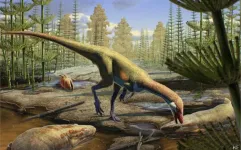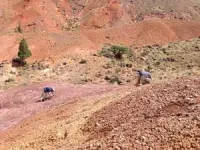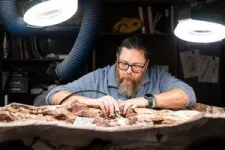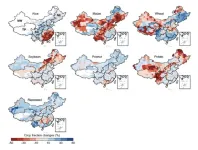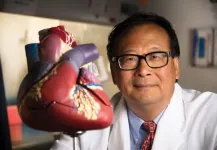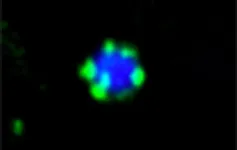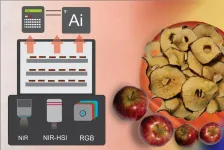(Press-News.org) MADISON — How and when did dinosaurs first emerge and spread across the planet more than 200 million years ago? That question has for decades been a source of debate among paleontologists faced with fragmented fossil records. The mainstream view has held that the reptiles emerged on the southern portion of the ancient supercontinent Pangea called Gondwana millions of years before spreading to the northern half named Laurasia.
But now, a newly described dinosaur whose fossils were uncovered by University of Wisconsin–Madison paleontologists is challenging that narrative, with evidence that the reptiles were present in the northern hemisphere millions of years earlier than previously known.
The UW–Madison team has been analyzing the fossil remains since they were first discovered in 2013 in present-day Wyoming, an area that was near the equator on Laurasia. The creature, named Ahvaytum bahndooiveche, is now the oldest known Laurasian dinosaur, and with fossils estimated to be around 230 million years old, it's comparable in age to the earliest known Gondwanan dinosaurs.
UW–Madison scientists and their research partners detail their discovery Jan. 8, 2025, in the Zoological Journal of the Linnean Society.
"We have, with these fossils, the oldest equatorial dinosaur in the world — it's also North America's oldest dinosaur," says Dave Lovelace, a research scientist at the University of Wisconsin Geology Museum who co-led the work with graduate student Aaron Kufner.
Discovered in a layer of rock known as the Popo Agie Formation, it took years of careful work by Lovelace and his colleagues to analyze the fossils, establish them as a new dinosaur species and determine their estimated age.
While the team doesn't have a complete specimen — that's an exceedingly rare occurrence for early dinosaurs — they did find enough fossils, particularly parts of the species' legs, to positively identify Ahvaytum bahndooiveche as a dinosaur, and likely as a very early sauropod relative. Sauropods were a group of herbivorous dinosaurs that included some famously gigantic species like those in the aptly named group of titanosaurs. The distantly related Ahvaytum bahndooiveche lived millions of years earlier and was smaller — much smaller.
"It was basically the size of a chicken but with a really long tail," says Lovelace. "We think of dinosaurs as these giant behemoths, but they didn't start out that way."
Indeed, the type specimen of Ahvaytum bahndooiveche, which was full-grown but could have been slightly bigger at its maximum age, stood a little over one foot tall and was around three feet long from head to tail. Although scientists haven’t found its skull material, which could help illuminate what it ate, other closely related early sauropod-line dinosaurs were eating meat and would likely have been omnivorous.
The researchers found the few known bones of Ahvaytum in a layer of rock just a little bit above those of a newly described amphibian that they also discovered. The evidence suggests that Ahvaytum bahndooiveche lived in Laurasia during or soon after a period of immense climatic change known as the Carnian pluvial episode that has previously been connected to an early period of diversification of dinosaur species.
The climate during that period, lasting from about 234 to 232 million years ago, was much wetter than it had been previously, transforming large, hot stretches of desert into more hospitable habitats for early dinosaurs.
Lovelace and his colleagues performed high-precision radioisotopic dating of rocks in the formation that held Ahvaytum’s fossils, which revealed that the dinosaur was present in the northern hemisphere around 230 million years ago. The researchers also found an early dinosaur-like track in slightly older rocks, demonstrating that dinosaurs or their cousins were already in the region a few million years prior to Ahvaytum.
"We're kind of filling in some of this story, and we're showing that the ideas that we've held for so long — ideas that were supported by the fragmented evidence that we had — weren’t quite right,” Lovelace says. “We now have this piece of evidence that shows dinosaurs were here in the northern hemisphere much earlier than we thought."
While the scientific team is confident they've discovered North America's oldest dinosaur, it's also the first dinosaur species to be named in the language of the Eastern Shoshone Tribe, whose ancestral lands include the site where the fossils were found. Eastern Shoshone tribal elders and middle school students were integral to the naming process. Ahvaytum bahndooiveche broadly translates to "long ago dinosaur" in the Shoshone language.
Several tribal members also partnered with Lovelace and his UW–Madison colleagues as the researchers sought to evolve their field practices and better respect the land by incorporating the knowledge and perspectives of the Indigenous peoples into their work.
"The continuous relationship developed between Dr. Lovelace, his team, our school district, and our community is one of the most important outcomes of the discovery and naming of Ahvaytum bahndooiveche," says Amanda LeClair-Diaz, a co-author on the paper and a member of the Eastern Shoshone and Northern Arapaho Tribes. LeClair-Diaz is the Indian education coordinator at Fort Washakie school and coordinated the naming process with students and tribal elders — a process that started under her predecessor, Lynette St. Clair.
"Typically, the research process in communities, especially Indigenous communities, has been one sided, with the researchers fully benefiting from studies," says LeClair-Diaz. "The work we have done with Dr. Lovelace breaks this cycle and creates an opportunity for reciprocity in the research process."
END
Dinosaurs roamed the northern hemisphere millions of years earlier than previously thought, according to new analysis of the oldest North American fossils
2025-01-08
ELSE PRESS RELEASES FROM THIS DATE:
Breakthrough Durham University research offers new insights into quenching electrical waves in the heart
2025-01-08
-With images-
Scientists at Durham University have developed a theoretical framework to predict the efficacy of quenching of electrical pulses in excitable media, such as those found in the human heart.
This breakthrough could significantly accelerate the development of more efficient defibrillation techniques for treating cardiac arrhythmias.
The study, published in Physical Review E, addresses a longstanding challenge in understanding how stable excitation waves in systems like cardiac tissue can be effectively neutralised through small changes.
These electrical waves, when irregular, are thought to underly serious conditions such as fibrillation, ...
SLAC will play a key role in DOE’s new research centers for advancing next-generation microelectronics
2025-01-07
Around the globe day and night, the microelectronics behind much of modern technology help run computers, medical devices and state-of-the-art instruments that power scientific discoveries. But all of that technology consumes energy, and adding artificial intelligence to the mix increases our energy needs dramatically. Some experts caution that this pace of energy usage is unsustainable.
To tackle this challenge, the Department of Energy (DOE) has announced funding $179 million for three Microelectronics ...
Market researchers and online advertisers, are A-B tests leading you astray? A new study says they could be
2025-01-07
Researchers from Southern Methodist University and University of Michigan published a new Journal of Marketing study that examines platforms’ A-B testing of online ads and uncovers significant limitations that can create misleading conclusions about ad performance.
The study, forthcoming in the Journal of Marketing, is titled “Where A-B Testing Goes Wrong: How Divergent Delivery Affects What Online Experiments Cannot (and Can) Tell You About How Customers Respond to Advertising” and is authored by Michael Braun and Eric M. Schwartz.
Consider a landscaping company whose designs focus ...
Research alert: Ketamine use on the rise in U.S. adults; new trends emerge
2025-01-07
A recent study analyzing data from the National Survey on Drug Use and Health (NSDUH) found that past-year recreational ketamine use among adults has increased dramatically since 2015, including significant shifts in associations with depression and sociodemographic characteristics such as race, age and education status. Ketamine use has shown promise in clinical trials therapy for several mental illnesses, including treatment-resistant depression, and the new research suggests that ongoing monitoring of recreational use trends is crucial to balancing these ...
Crop switching for climate change in China
2025-01-07
A study of Chinese agriculture recommends planting areas currently growing maize and rapeseed with alternative crops to reduce environmental costs while maximizing food production as the climate changes.
Chinese food production has nearly doubled since the 1980s, mainly thanks to intensified nutrient usage and irrigation. Given that China’s demand for food is forecast to increase further, Qi Guan and colleagues modeled the country’s agricultural system under varying climate change scenarios in the 21st century, using a dynamic global vegetation model. The authors created scenarios ...
Cell-based therapy improves outcomes in a pig model of heart attacks
2025-01-07
BIRMINGHAM, Ala. – In a large-animal model study, researchers have found that heart attack recovery is aided by injection of heart muscle cell spheroids derived from human induced pluripotent stem cells, or hiPSCs, that overexpress cyclin D2 and are knocked out for human leukocyte antigen classes I and II. This research, published in the journal Circulation Research, used a pig model of heart attacks. Pig hearts more closely resemble the human heart in size and physiology, and thus have a higher clinical relevance to human disease, compared to studies in mice.
University of Alabama at Birmingham researchers, led by Jianyi “Jay” ...
Researchers have a better understanding of how our cells dispose of waste while developing ways to control it
2025-01-07
Recycling takes place in our cells at all times: in a process called autophagy, cell components that are no longer needed are enclosed by membranes and broken down into their basic building blocks. This vital process prevents the formation of harmful aggregates and makes nutrients available again. A research team co-led by Prof. Dr. Claudine Kraft from the CIBSS Cluster of Excellence at the University of Freiburg and Dr. Florian Wilfling from the Max Planck Institute of Biophysics in Frankfurt has now discovered the conditions necessary for autophagy to start. They were also able ...
Earth’s air war: Explaining the delayed rise of plants, animals on land
2025-01-07
New Haven, Conn. — If you like the smell of spring roses, the sounds of summer birdsong, and the colors of fall foliage, you have the stabilization of the ozone layer to thank for it. Located in the stratosphere, where it shields the Earth from harmful ultraviolet radiation, the ozone layer plays a key role in preserving the planet’s biodiversity.
And now we may have a better idea of why that took so long — more than 2 billion years — to happen.
According to a new, Yale-led study, ...
More than half of college students report alcohol-related harms from others
2025-01-07
FOR IMMEDIATE RELEASE
Tuesday, January 7, 2025
Contact:
Jillian McKoy, jpmckoy@bu.edu
Michael Saunders, msaunder@bu.edu
##
More than half of US college students experienced alcohol-related harms caused by others, according to the first national probability-based survey of such harms conducted in 20 years. The findings, published in the journal Drug and Alcohol Review in December, shed light on how others’ drinking affects students’ health, academics, and safety.
“Our research ...
Smart food drying techniques with AI enhance product quality and efficiency
2025-01-07
URBANA, Ill.– Food drying is a common process for preserving many types of food, including fruits and meat; however, drying can alter the food’s quality and nutritional value. In recent years, researchers have developed precision techniques that use optical sensors and AI to facilitate more efficient drying. A new study from the University of Illinois Urbana-Champaign discusses three emerging smart drying techniques, providing practical information for the food industry.
“With traditional drying systems, you need to remove samples to monitor the process. But with smart drying, or precision drying, you can continuously ...
